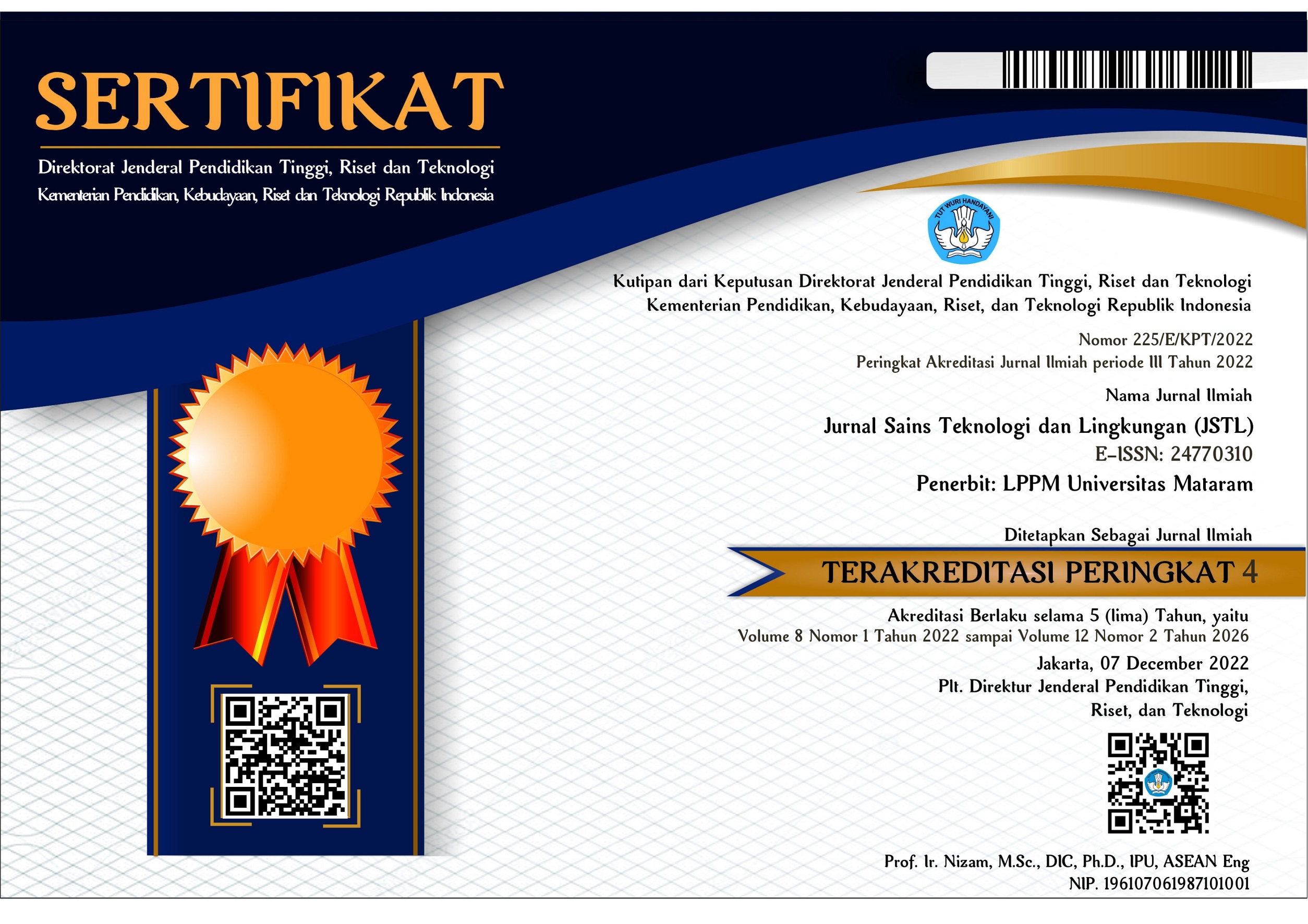Karakteristik Infiltrasi dan Potensi Irigasi di Lahan Kering Kecamatan Bayan Kabupaten Lombok Utara
DOI:
https://doi.org/10.29303/jstl.v7i1.239Keywords:
lassification, rate, fast, medium, slowAbstract
Agricultural development with horticultural crops on dry land is one of the government's efforts to increase dry land productivity so that new paddy fields are created in the Bayan area. Noting that land infiltration capability and its classification are important factors needed in irrigation planning to support the development of horticultural agriculture, so it is necessary to conduct field research on this matter. This study aims to determine the characteristics and classification of land infiltration and determine the trend of irrigation that can be applied. Field infiltration tests were carried out in Anyar and Sukadana villages with 4 test points each. The infiltration rate test in the field was carried out using a double ring infiltrometer and a soil test at the Geotechnical Laboratory, Faculty of Engineering, Unram. Analysis of the data used Horton's formula as a comparison and the results of the analysis were presented in the form of tables and graphs, conclusions were made descriptively. The results showed that the average infiltration rate in Anyar Village was at point 1 = 26.90 cm/hour, point 2 = 14.94 cm/hour, point 3 = 27.33 cm/hour, and point 4 = 8.21 cm/hour with soil including sandy clay. Infiltration rate classification of points 1 and 3 is very fast, point 2 is fast and location 4 is rather fast. For Sukadana Village the infiltration rate was obtained at point 1 = 43.52 cm/hour, point 2 = 36.67 cm/hour, point 3 = 12.86 cm/hour, and point 4 = 10.97 cm/hour, with the condition sandy clay soil. Sukadana's infiltration rate classification points 1 and 2 are very fast and points 3 and 4 are rather fast. Based on the results of the infiltration test, for very fast and fast infiltration, it is potential to apply jet irrigation such as sprinklers or perforations and for rather fast infiltration, drip irrigation can be applied with limited drip systemReferences
Hardiyatmo. 2006. Mekanika Tanah 1.
Hastuti. 1982. Kadar Lengas Tanah, http://tonothemycry.blogspot.co.id// 22 Oktober 2017.
Priyono J.,Yasin I.,Dahlan M.,Bustan. 2019. Identification the properties, Charakteritics, and Type of main Soils in Lombok Island, Jurnal Sains Teknologi dan Lingkungan,Vol 5 No1, ISSN: 2477-0329 .hal 19- 24, LPPM Unram, Mataram
Randy R. 2012. Analisis krakteristik Infiltrasi Hamparan Lahan Kering di Desa Pringgabaya Utara, Skripsi,FT.Unram, Mataram
Haki Y.2013. Analisis Peningkatan Potensi Infiltrasi pada Tanah Berbutir Halus dengan Mencapurkan Tanah berbutir kasar di Lahan kering Desa pringgabaya Utara. Skripsi FT Unram, Mataram
Jaya Negara.IDG., Saadi Y., Putra IB. 2014. Karakteristik Perubahan Lengas Tanah pada Pemberian Irigasi Tetes Pipa PVC di Lahan Kering Pringgabaya Kabupaten Lombok Timur.Jurnal Spektrum Sipil, Vol 1 No 2, hal 112-211. ISSN 1858-4896
Suryanto.J.2017, Penentuan Laju infiltrasi di Lahan Pertanian Kecamatan Sangatta Selatan dengan Model Infiltrasi Terpilih, Jurnal Pertanian Terpadu. Vol 5 No 1 Juni 2017, hal 56-67.
Triatmodjo B. 2008. Hidrologi Terapan. Yogyakarta: Beta Offset.
Yunagardasari,C., Paloloang A K., Monde A. 2017. Infiltration Model in Different Landuse in Desa Tulo Kecamatan Dolo Kabupaten Sigi. e-J. Agrotekbis 5 (3) : 315 - 323, Juni 2017 ISSN : 2338-3011.



1.png)











